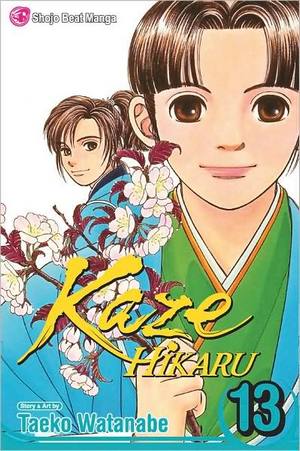- Comics
- Comics Reviews
- Manga
- Comics Reviews
- European Comics
- News
- Comics News
- Press Releases
- Columns
- Spotlight
- Digital Comics
- Webcomics
- Cult Favorite
- Back Issues
- Webcomics
- Movies
- Toys
- Store
- More
- About
By Leroy Douresseaux
April 30, 2009 - 09:22
 |
| Kaze Hikaru Volume 13 cover image is courtesy of barnesandnoble.com. |
Rated “T+” for “Older Teen”
It’s the 1860s, and a new era is dawning – a time of tremendous social upheaval. Into this comes Tominaga Sei, the daughter of a samurai who disguises herself as a boy to avenge her Bakufu bushi (samurai) father and brothers. She takes the name Kamiya Seizaburo and joins the Shinsengumi, a band of warriors formed to protect the Shogunate system. Aspiring to be a true bushi, Kamiya trains under Okita Soji, the young man she loves and the only person in the Shinsengumi who knows Kamiya’s true identity.
As Kaze Hikaru, Vol. 13 opens, the Shinsengumi completes its move into its new headquarters at Nishi Honganji in Kyoto. Kamiya continues to impress her superiors, but more complications begin to enter her life. First, she befriends Miki Saburo, the overweight, outcast brother of Ito Kashitaro, councilor of the Shinsengumi. The plumb Miki struggles with insecurity over his brother’s constant criticism of him, so he comes to adore Kamiya for paying attention to him. However, their bonding leads to a drunken night that nearly ends in disaster.
Meanwhile, Okita has been asked to go on a recruiting trip to Edo, and he doubts that Kamiya can fend for herself while he’s gone. He finds her martial skills to be poor, although Kamiya honestly trains with such diligence. Okita’s doubts lead him to deliver a shocking ultimatum to Kamiya.
THE LOWDOWN: After the semi-malaise of the previous volume, the chapters contained in Volume 13 of Kaze Hikaru are a return to character drama that isn’t just… well, drama, but also humorous, heartwarming, heart-wrenching, and exhilarating. That wide open sense of history – that sensation of experiencing an epic story – returns to engage the reader, whereas the focus on the recent ritual suicide of a favorite character seemed too personal, introspective, and even too small for this historical romance.
It’s also interesting that creator Taeko Watanabe art seems more feminine in its depiction of both male and female characters. The male characters, even the more masculine or martial ones, are feminized as these stories focus on romantic love, familial devotion, and an adoration of friends – soft themes that are associated with the feminine. This allows for a fascinating look at the intimate bonds that connect these characters to one another.
POSSIBLE AUDIENCE: Fans of Japanese historical fiction and samurai drama will absolutely love Kaze Hikaru.
A